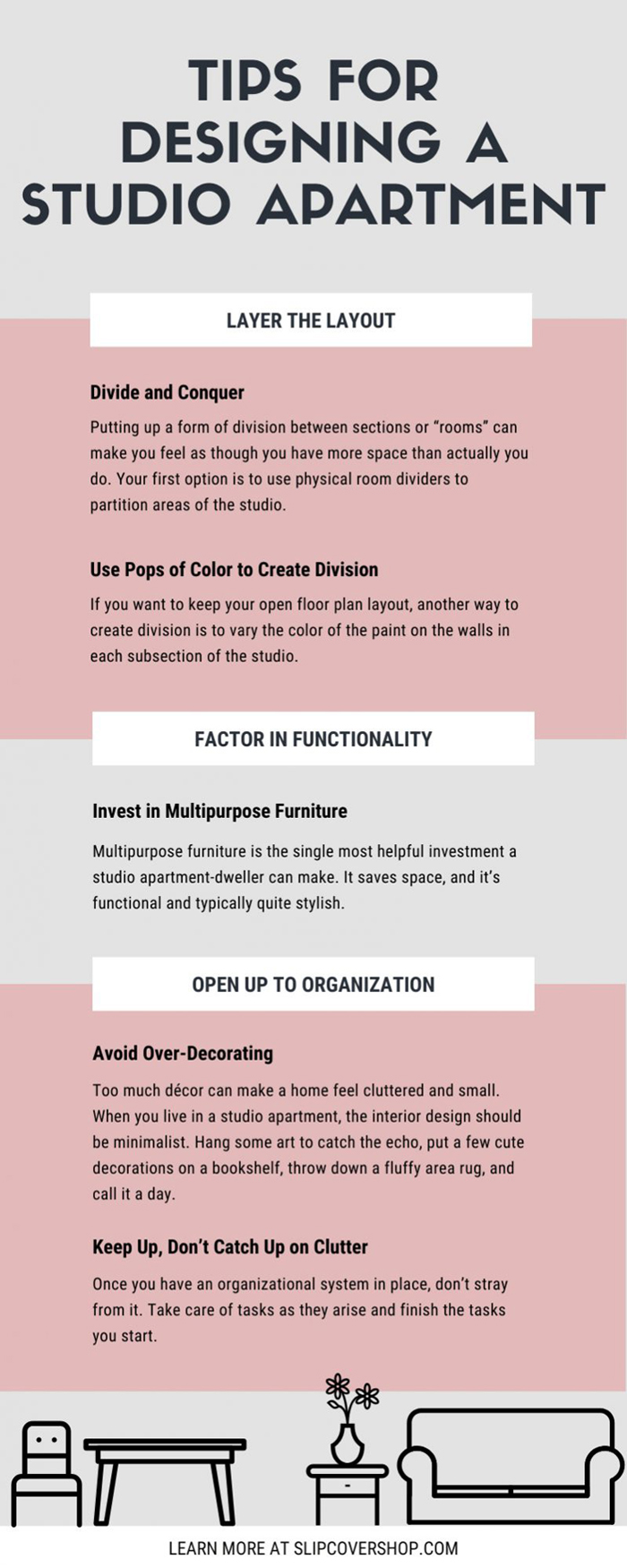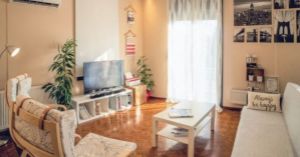So many cities are moving to smaller housing models, and with the trendiness of tiny living spaces and minimalist lifestyles right now, there’s no better time to move into a studio apartment. Studio apartments aren’t just for college kids anymore—they’re available in great neighborhoods for working adults, too. The key to making a studio apartment feel spacious and homey lies in the design. Check out this guide of helpful tips for designing a studio apartment to make your space useful and appealing.
Layer the layout
Even though a studio apartment is typically only a single room—some lucky studio renters may get a separate kitchen, but not many—there are several ways to create the illusion of separate rooms. Division can help your space feel more dynamic and less cramped.
Divide and conquer
Putting up a form of division between sections or “rooms” can make you feel as though you have more space than actually you do. Your first option is to use physical room dividers to partition areas of the studio. There are multiple options for room-dividing materials, depending on your space and style preference:
- Room dividers: Use glass panel room dividers to divide space without making sections feel cramped or closed off. These are perfect for studios with limited natural lighting because they divide without blocking light.
- Bookshelves: Dividing a room up with bookshelves is a great way to indicate separate spaces while allowing for storage space, décor, and a bit of light in each section. This is the perfect choice for a studio with limited storage space.
- Floor-to-ceiling curtains: Floor-to-ceiling curtains are customizable and relatively easy to hang. Go with light and airy curtains to let light through, or get blackout curtains for daytime sleeping. These are perfect for studios with limited space, as you can easily place them right up against the side or foot of a bed.
- Clothing racks: Clothing racks also make for great room dividers. Place them along the “room lines” you wish to create and fill them with clothing. This is perfect for studios with limited closet space. For more style in your studio design, place all of the same-colored clothing on each rack. This gives the dividers a sleek and intentional look while limiting the feel of distraction and clutter.
- Furniture: Putting a couch up against the footboard of a bed is a great way to signify you’re entering a new space. This method is best for oddly shaped spaces that you might have trouble dividing otherwise. Set up each “room” as a separate space so that it feels distinct from the other spaces.
Use pops of color to create division
If you want to keep your open floor plan layout, another way to create division is to vary the color of the paint on the walls in each subsection of the studio. For example, you could paint the “bedroom” section an off-white color, the “living room” a light blue, and the “kitchen” a dark blue. This way, you keep the same overall tone and cohesion within the space while differentiating between rooms.
Factor in functionality
Functionality is key in any living space, but the need for a usable space is essential to studio apartment living. Most furniture pieces and even decorations should have multiple uses to save space.
Invest in multipurpose furniture
Multipurpose furniture is the single most helpful investment a studio apartment-dweller can make. It saves space, and it’s functional and typically quite stylish. There are multiple ways to add multipurpose furniture to your home:
- Futon: Investing in a really comfy futon is key to balancing functionality and style in a studio. You can use your futon as a couch as well as a bed. Simply invest in a futon cover to protect your purchase, to keep your bed/couch cozy, and to add a pop of color.
- Sneaky storage: Sneaky storage solutions include furniture items that appear normal but that really act as secret storage agents. For example, a trunk that doubles as a coffee table or an ottoman or kitchen bench with hidden storage space inside are all good sneaky storage options.
Open up to organization
Organization is one of the most important factors in making a small space feel large. When you’re designing your studio apartment, think about how you’ll organize the space and your belongings for the most logical yet aesthetically pleasing manner.
Hide everything you can
Stash away anything you can store in a basket, decorative box, closed cubby hole, or other out-of-sight storage option. The less items you have lying about, the less cluttered and overwhelming your space will feel. Try to keep this storage system organized by keeping similar things in similar places.
Avoid over-decorating
Decorating is a way to express yourself in the home, but too much of a good thing can be bad. When you live in a studio apartment, the interior design should be minimalist. Hang some art to catch the echo, put a few cute decorations on a bookshelf, throw down a fluffy area rug, and call it a day. Too much décor can make a home feel cluttered and small.
Keep up, don’t catch up on clutter
Once you have an organizational system in place, don’t stray from it. As temping as crawling back into bed after a long day of doing laundry can be, resist the urge to abandon folding or hanging your clothing. This type of task can pile up and become unmanageable if you leave it alone for too long. Here are some tips on staying ahead of the clutter:
- Take care of tasks as they arise: If you notice dishes are piling up, stop what you’re doing and load up the dishwasher or wash the dishes by hand. Don’t spill something and tell yourself you’ll clean it up later—"later” becomes “never,” and “never” leads to a cluttered and unlivable home.
- Finish the tasks you start: Once you start a task, don’t abandon it halfway through. If you leave a project half-finished, you may as well have never started it in the first place.


